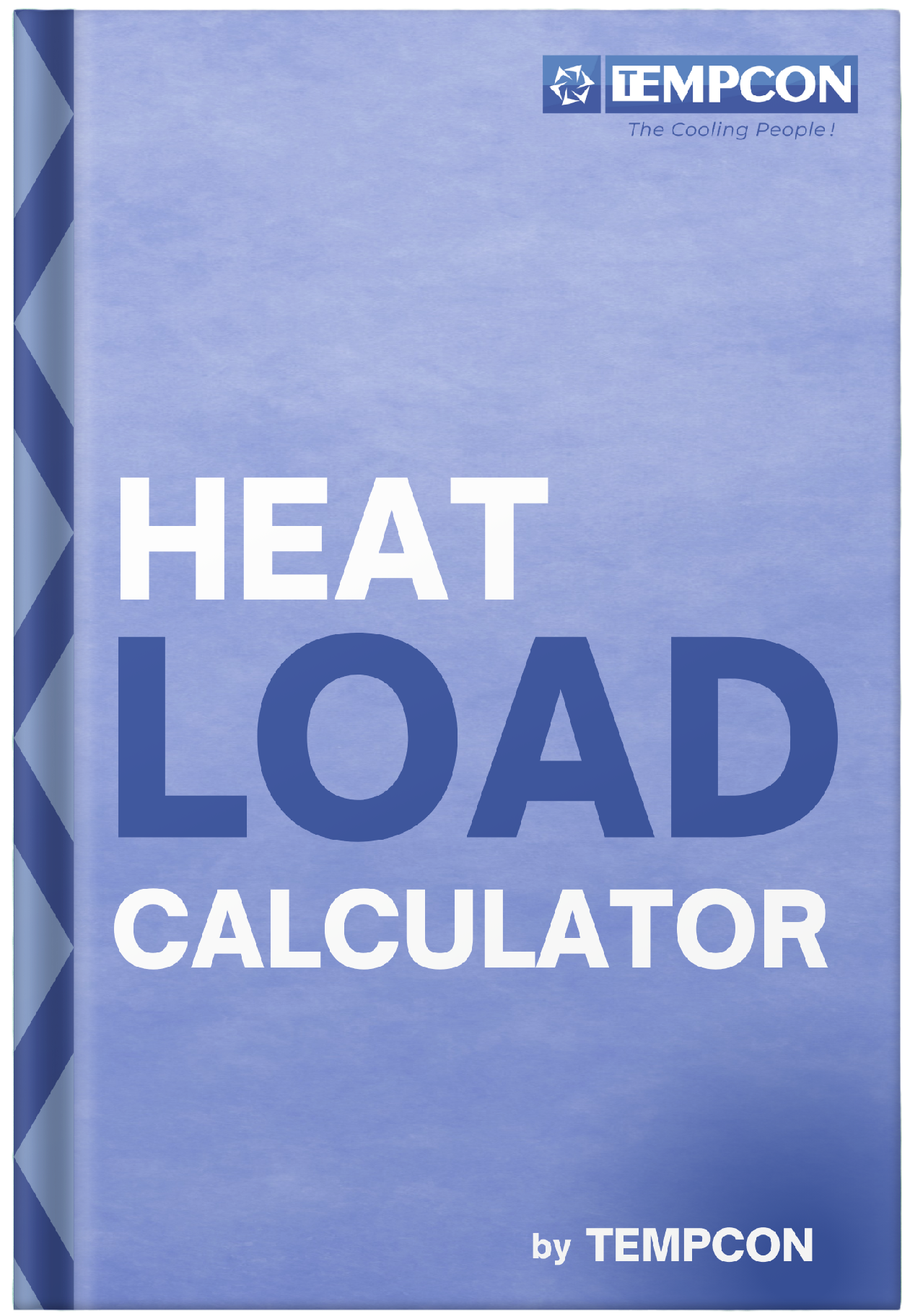Industries use chilling solutions for a wide variety of settings. But every chiller cannot serve the same purpose. There are several types of chillers in the market, all designed for a specific set of settings.
We at Tempcon have 9 different chiller types, each with different specifications. We’ll check all of those in detail in this article. But before we begin, let us introduce you to industrial chillers in general.
Introduction to Industrial Chillers
Industrial chillers are basically large-scale cooling systems that maintain the temperature of a room, machinery, warehouse, or factory. They are designed using a number of different methods, like evaporation, compressed refrigerant, or adsorption.
But they all serve the purpose of regulating the temperature so there are no overheating issues. That simply doesn’t mean you can pick any industrial cooling system at random. There are certain factors at play, which we will discuss in the following section.
Key Considerations When Choosing an Industrial Chiller
As discussed, there are several types of industrial chiller systems, and you have to choose the right fit for you. So, we’ll take you through the chiller selection criteria that we advise all our clients to follow.
-
Chiller efficiency
A chiller with higher efficiency should be the ideal choice. Ask the manufacturers/suppliers to get the exact efficiency of any cooling system. The chiller efficiency has a significant impact on the operational costs, which makes it a really important consideration.
For those who don’t know how chiller efficiency is measured, here’s a short overview – it is measured in terms of Coefficient of Performance (COP), which is a ratio of heat supplied or removed from the system to the total energy given to the system.
-
Chiller maintenance
Chiller systems need timely maintenance. Some are easier and cheaper to maintain, while others are expensive and need technical support for maintenance. We suggest considering all the resources and maintenance costs before deciding on a chiller.
-
Chiller capacity
Different chillers have different capacities to maintain a particular temperature range. Ensure that the chiller you are choosing operates within the required capacity. Lesser capacity can cause load on the chilling system, causing it to wear out. On the other hand, oversizing the chiller will increase unnecessary operational costs.
-
Chiller size and space availability
Industrial chillers come in different sizes. So before you buy, measure the space available at your plant and check whether the chosen chiller will fit into the space. If not, make alternative arrangements.
-
Chiller cost
While calculating the chiller cost, don’t just consider the MRP and taxes.
Also, take into account annual operational costs, energy costs, maintenance costs, and such. And then decide if it’s the right fit for you.
Types of Chillers for Industrial Applications
In this section, we will discuss some of the popular chiller types. The idea is to introduce you to different chillers so you can make an informed purchase decision.
We will also look at chiller advantages and disadvantages of each of the types.
1. Air-Cooled Scroll Chillers
Capacity Range: 3 TR to 50 TR
Temperature Range: (+) 5°C to (+) 20°C
Air-cooled scroll chillers are the most common type of chillers. They use a scroll compressor to cool the refrigerant, which in turn keeps the system cool. The air-cooled scroll chillers we manufacture and deliver use Hermetic Scroll compressors.
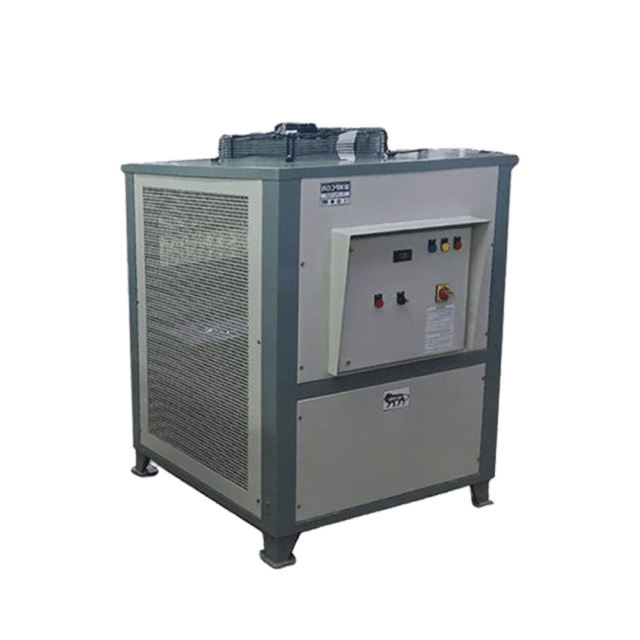
These are typically used for small-scale industries but can be installed indoors or outdoors with no additional protection. Some of the common applications include Injection Moulding, Blow Moulding, MRI Machine, Process Cooling, Oil Cooling, Film Extrusion Line, Compressed Moulding, Food Processing, Over Head Tank Water Cooling, and Concrete Batching.
Pros and Cons of Air-Cooled Scroll Chillers
| Pros | Cons |
| Energy-efficient | Less efficient in high temperatures |
| Compact design | It may not be suitable for hot climates |
| Lower upfront cost than water-cooled chillers | Lower efficiency than water-cooled chillers |
2. Air-Cooled Screw Chillers
Capacity Range: 0.5 TR to 100 TR
Temperature Range: (-) 40°C to (+) 25°C
Air-Cooled Screw Chillers are similar to Air-Cooled Scroll Chillers, but they use a screw compressor instead. We at Tempcon use Semi-hermetic screw compressors along with versatile fans. Screw compressors are known to be more efficient; hence these provide higher chiller efficiency.
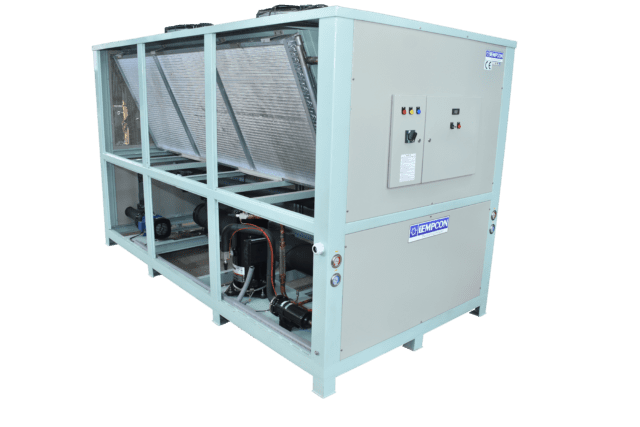
They are typically used in medium to large-scale applications. Some of the common ones include PVC, HDPE, UPVC Pipe Extrusion, Injection Moulding, Blow Moulding, Film Extrusion, Aluminum Extrusion, Concrete Batch Mixing, Food Processing, Industrial, Process Cooling, Galvanizing Plant, Dairy, Edible Oil, Brewery, and Raffia/Tep Plant.
Pros and Cons of Air-Cooled Screw Chillers
| Pros | Cons |
| Reduced energy consumption | More expensive than air-cooled scroll chillers |
| Increased performance | Larger footprint |
| Lowered operating costs | Louder in operation |
3. Water-Cooled Scroll Chillers
Capacity Range: 5 TR to 350 TR
Temperature Range: (-) 40°C to (+) 25°C
Water-Cooled Scroll Chillers are very similar to Air-Cooled Scroll Chillers. They, too, use a scroll compressor, but they need a constant water supply and cooling tower for operation. They are highly efficient and suitable for environments that need constant cooling at specific temperature ranges.
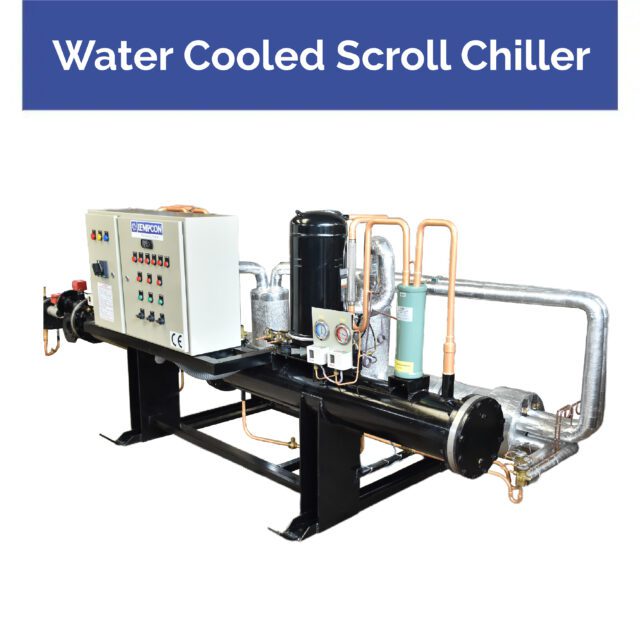 Some of the common applications of water-cooled scroll chillers are Metal Finishing, Injection Moulding, Blow Moulding, Electroplating, Galvanizing, Concrete Batch Mixing, Food Processing, Industrial Process Cooling, Carbonated Soft Drinks, Pharmaceutical, Dairy, and Brewery.
Some of the common applications of water-cooled scroll chillers are Metal Finishing, Injection Moulding, Blow Moulding, Electroplating, Galvanizing, Concrete Batch Mixing, Food Processing, Industrial Process Cooling, Carbonated Soft Drinks, Pharmaceutical, Dairy, and Brewery.
Pros and Cons of Water-Cooled Scroll Chillers
| Pros | Cons |
| Well-suited for constant cooling needs | Require a constant water supply |
| Longer lifespan | More expensive than air-cooled scroll chillers |
| It can be used in hot climates | Higher initial cost |
4. Water-Cooled Screw Chillers
Capacity Range: 30 TR to 350 TR
Temperature Range: (-) 40°C to (+) 25°C
Water-Cooled Screw Chillers use screw compressors and a water-cooling tower but have the same operation as air-cooled screw chillers. But these are designed for large-scale applications. They have higher capacity, better efficiency, flexibility, reliability, and performance than other chiller types.
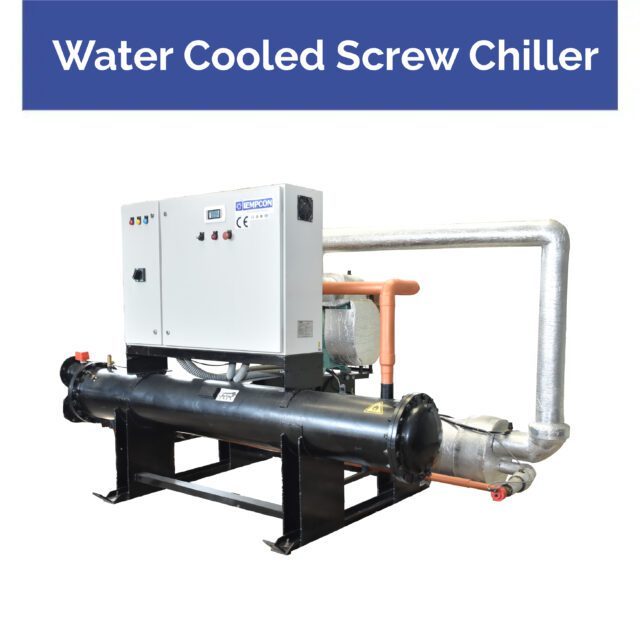 Tempcon chillers are used in the following industries with great reliability: PVC, HDPE, UPVC Pipe Extrusion, Injection Moulding, Blow Moulding, Film Extrusion, Aluminum Extrusion, Concrete Batch Mixing, Food Processing, Industrial Process Cooling, Galvanizing Plant, Raffia Tep Plant, Pharmaceutical, and Edible Oil Manufacturing.
Tempcon chillers are used in the following industries with great reliability: PVC, HDPE, UPVC Pipe Extrusion, Injection Moulding, Blow Moulding, Film Extrusion, Aluminum Extrusion, Concrete Batch Mixing, Food Processing, Industrial Process Cooling, Galvanizing Plant, Raffia Tep Plant, Pharmaceutical, and Edible Oil Manufacturing.
Pros and Cons of Water-Cooled Screw Chillers
| Pros | Cons |
| Excellent for large-scale cooling | Constant water supply is needed |
| High efficiency | Higher maintenance |
| High-pressure pumps | More expensive |
5. Oil Chillers
Capacity Range: 0.5 TR to 20 TR
Temperature Range: (+) 15°C to (+) 40°C
Oil Chillers are used to cool a wide variety of fluids, including oils, glycol, and water. They prevent overheating of equipment due to fluids and, in turn, extend the lifespan of the equipment. We urge you to leverage our 38 years of experience and credibility in selling oil chillers for your own industry.
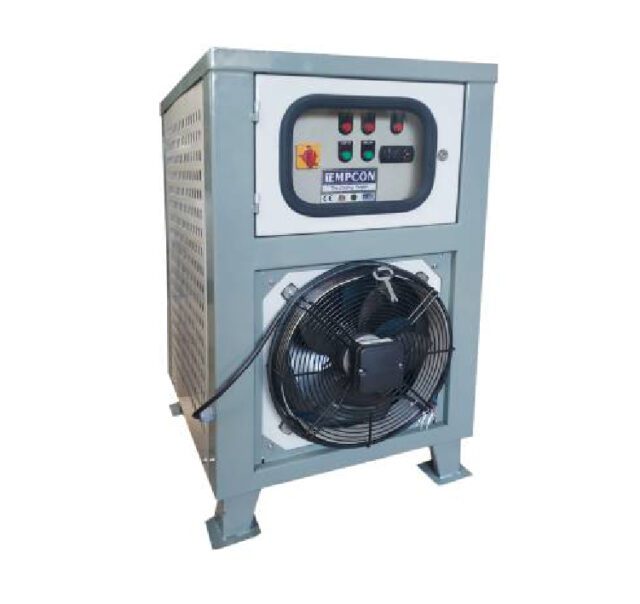
It is popular in Hydraulic Oil Cooling, Coolant Cooling, Cutting Oil Cooling, CNC Machine, Hydraulic Power Pack, Hydraulic Press, Automobile Industry, Quenching Oil Cooling, and Machine Tool Industry.
Pros and Cons of Oil Chillers
| Pros | Cons |
| Prevent overheating of oils | Limited versatility |
| Extended equipment lifespan | Higher upfront and operating costs |
| Can achieve low temperatures | It may require special safety precautions |
6. Glycol/Brine Chillers
Capacity Range: 1 TR to 100 TR
Temperature Range: (-) 50°C to (+) 4°C
Glycol/Brine Chillers use glycol or brine as the refrigerant. They are designed to operate at very low temperatures. Our glycol and brine chillers use a variety of compressors, including Semi-Hermetic Reciprocating Compressors, Scroll Compressors, and Open Type Screw Compressors. We even offer custom chillers based on capacity requirements and application.
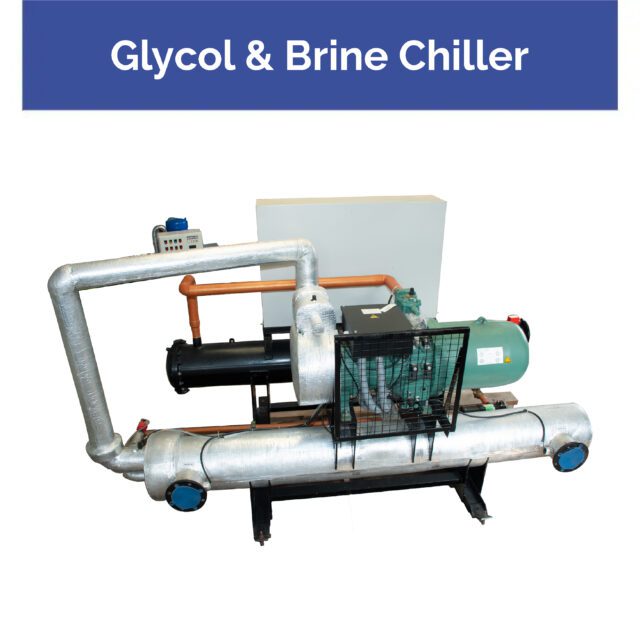 Brine and glycol chillers are used in industries like Active Pharmaceutical Ingredients, Carbonated Beverages, Breweries, Oil Extrusion, Edible Oil Processing, Micro-Breweries, Sulphuric Acid Manufacturing, Carbonation, Gas Extrusion, Aerospace Research, Defense Technology, Laboratory and Research, and Dairy.
Brine and glycol chillers are used in industries like Active Pharmaceutical Ingredients, Carbonated Beverages, Breweries, Oil Extrusion, Edible Oil Processing, Micro-Breweries, Sulphuric Acid Manufacturing, Carbonation, Gas Extrusion, Aerospace Research, Defense Technology, Laboratory and Research, and Dairy.
Pros and Cons of Glycol/Brine Chillers
| Pros | Cons |
| Ideal for low-temperature applications | Need glycol or brine as a heat transfer fluid |
| Prevent freezing of fluids | Energy-intensive |
| Accurate temperature control | Require special maintenance |
7. Reciprocating Chillers
Capacity Range: 1 TR to 50 TR
Temperature Range: (-) 30°C to (+) 17°C
Reciprocating Chillers are one of the oldest types of industrial chillers. They use a reciprocating compressor for cooling the refrigerant. We usually employ two types of compressors in our reciprocating chillers, viz. Semi-Hermetic Reciprocating Compressors and Hermetic Sealed Reciprocating Compressors. They are cost-effective options for industries.
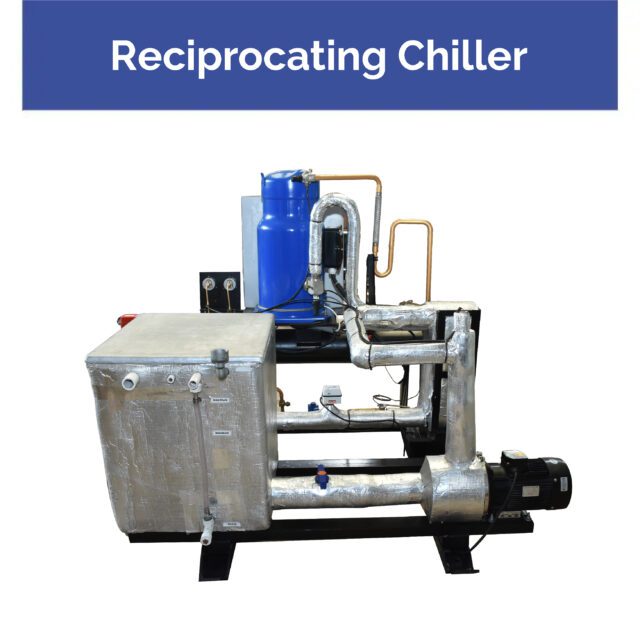
These are ideal for small-scale operations in industries like Carbonated Beverages, Breweries, Oil Extrusion, Edible Oil Processing, Sulphuric Acid Manufacturing, Carbonation, Gas Extrusion, Pharmaceutical Application, Aerospace Research, Defense Technology, Laboratory and Research, and Petrochemical.
Pros and Cons of Reciprocating Chillers
| Pros | Cons |
| Relatively low cost | Lower efficiency than other chiller types |
| Easy to maintain | Loud operation |
| Simple installation | Limited capacity |
8. VFD Chillers
Capacity Range: 3 TR to 30 TR
Temperature Range: (+) 5°C to (+) 12°C
VFD Chillers use Variable Frequency Drives (VFD) to control the speed of compressors. They give a wider operating capacity and enable precise control over chiller temperature. They are more efficient than non-VFD chillers. Tempcon VFD Chillers allow total capacity control from 10% to 100% with built-in or external VFDs.
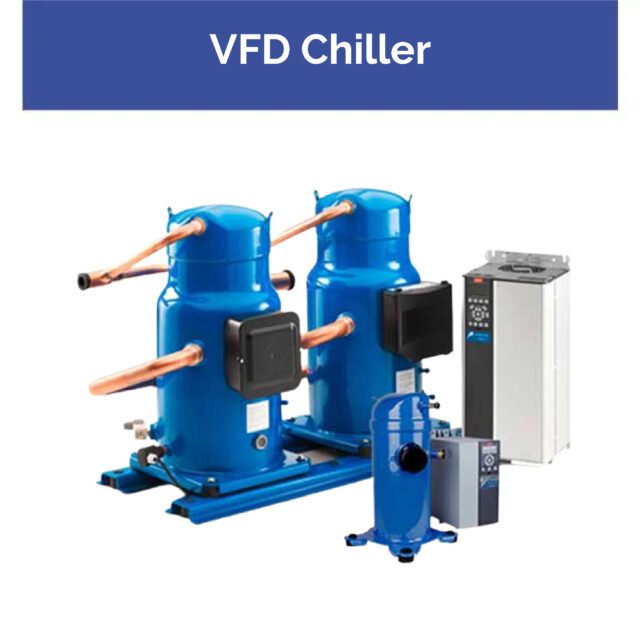 They are used in large-scale industries where precision is of the most importance. These include Food Processing, Injection Moulding, Blow Moulding, Medical Equipment, Solar Panel Manufacturing, Aerospace Research, Active Pharmaceutical Ingredients, and HVAC.
They are used in large-scale industries where precision is of the most importance. These include Food Processing, Injection Moulding, Blow Moulding, Medical Equipment, Solar Panel Manufacturing, Aerospace Research, Active Pharmaceutical Ingredients, and HVAC.
Pros and Cons of VFD Chillers
| Pros | Cons |
| High precision | Expensive |
| Wide operating capacity | High Maintenance |
| Higher efficiency than non-VFD chillers | Complex use |
9. Ammonia Chillers
Capacity Range: 30 TR to 300 TR
Temperature Range: (+) 4°C to (-) 40°C
Ammonia Chillers use eco-friendly ammonia refrigerants instead of complex ones. These are more environment-friendly than any other chillers. But ironically, ammonia itself is highly toxic. So, these require utmost care and maintenance. They are usually used in applications where very low temperatures and high cooling capacities are necessary.
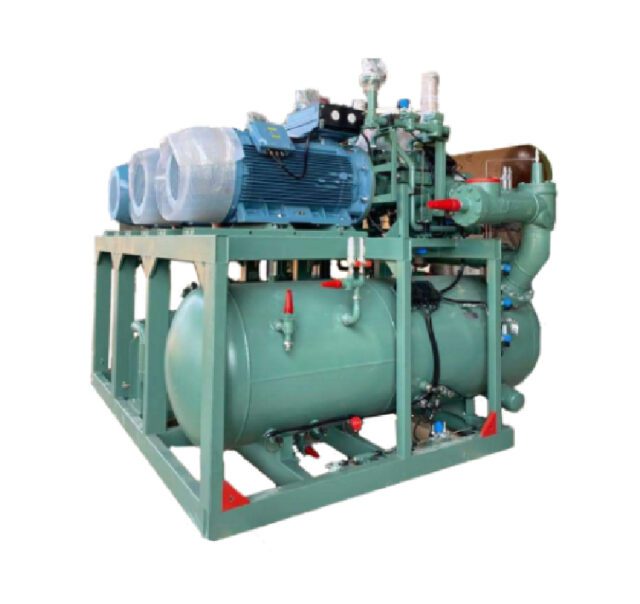
Our ammonia chillers are generally used for Carbonated Beverages, Breweries, Edible Oil Processing, Sulphuric Acid Manufacturing, Gas Extrusion, Pharmaceutical Applications, Aerospace Research, Defense Technology, Laboratory and Research, Petro Chemical, Fish Processing, Dairy, Meat Processing, and Food Processing.
Pros and Cons of Ammonia Chillers
| Pros | Cons |
| Environment-friendly refrigerant | Toxicity possibilities |
| Low carbon footprint | Need trained operational personnel |
| Highly efficient | High maintenance |
Applications of Industrial Chillers
Now that we have taken a look at various types of industrial chillers let’s understand where they are used and look at some of the real-life chiller applications.
Where Are Industrial Chillers Used?
Industrial cooling solutions are used in a wide variety of industries, including but not limited to
- Food Processing
- Healthcare
- Pharmaceuticals
- Automobile
- Plastic Manufacturing
- Oil and Gas
- Chemical
- Power industry
- Steel Manufacturing
- Building and Construction
- Diary
- Data Centers
- Machine Tools Production
- Brewery and Beverages
- Printing
- Solar and Wind Energy
- Vacuum Systems
Real-World Examples of Industrial Chiller Applications
Some of the real-world applications of industrial chillers are:
- Dairy industry: Chillers are used to cool milk during processing at a dairy.
- Pharmaceutical industry: Vaccines are chilled using industrial coolers during manufacturing, post-production, and in transit.
- Chemical industry: Condensers are required to cool down reaction mixture vapors during chemical synthesis.
- Plastic manufacturing: Plastic needs to be cooled down to mold into distinct shapes. This is sometimes achieved with the help of industrial chillers.
- Data center: A room full of servers needs to be well-ventilated and cooled down often to keep the computers from overheating. Chiller systems are a great help.
Conclusion
Now that you know your options, it should be easier to decide which chiller is the best for you. There are a few chillers that can be used for the same application. Choosing becomes difficult in such cases. But worry not. We have discussed the exact details that you should consider while buying an industrial chiller in the section above.
We’ll give you just a short recap in the next section. But know that if you need more help, our Tempcon executives are more than happy to help you make the right chiller choice for your industry.
Choosing the Right Chiller for Your Industrial Needs
Chiller selection should depend on the following aspects:
- Efficiency of the chiller: Determine how efficient your chiller needs to be. Don’t invest in a chiller that has more specifications than you need.
- Maintenance of the chiller: Industrial chillers with easier maintenance and fewer maintenance costs should be preferred.
- Capacity of the chiller: Evaluate your capacity requirements before looking for a chiller.
- Size of the chiller: Make sure you have the appropriately sized installation area for the chiller you choose.
- Resources Availability: Resources like water and electricity should be available within the required limits of your industrial chiller.
The Future of Industrial Cooling: Trends and Innovations
Industrial cooling has been around for decades. We see newer advancements every now and then. Chillers have come a long way from how they used to be. They are no longer simple water-based cooling systems. They use developed materials and advanced engineering.
We hope to see a similar development in the future. We believe industrial chiller trends will include the use of Artificial Intelligence and Machine Learning to automatically register the changes in the surroundings, and the system will self-adjust accordingly.
